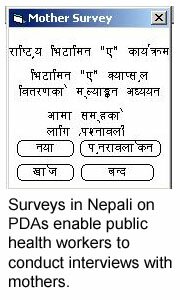 |
||
|
|
DOT-COM HOME https://dot-com-alliance.org/index.htm
Contact Us https://dot-com-alliance.org/contact.htm |
|
|||
|
|||
|
Piloting PDAs to Improve Data Collection and Monitoring of Health Projects in Nepal Imagine the near instant collection and analysis of essential health data, at the fingertips of policy and decision makers! This is no longer a dream. Through the use of information and communications technologies (ICTs), data collection and analysis can be cost effective and efficient - if used appropriately. USAID/Nepal and USAID/Asia and Near East Bureau (ANE) are funding the dot-ORG Nepal Health Monitoring Pilot Project to explore the use of ICTs for health monitoring. With SATELLIFE and other dot-ORG partners, the project is testing hand-held computers or personal digital assistants (PDAs) and global positioning systems (GPS) to be used by community health workers to quickly and accurately collect important survey data on vitamin A distribution.  Answering Critical Questions about PDAs for Data Collection Answering Critical Questions about PDAs for Data CollectionA mix of computer and communication technologies can enable Ministry officials and health NGOs to quickly collect data on a disease outbreak, analyze collected routine data, and efficiently produce reports for decision makers so they can respond before the outbreak spreads to new areas or change the intervention to target critical regions. These scenarios sound ideal, and before these digital technologies are used on a large scale several critical questions need to be answered. How can and should these technologies actually be used in developing country situations? What are the costs involved? What are the benefits of using these technologies over conventional approaches? What are the opportunities and the limitations of both the technology and the human resources needed for technology enhanced data collection? These are some of the questions that the ANE Bureau and USAID/Nepal have set out to answer through the Nepal Health Monitoring Pilot Project. This activity is based in part on the experience of SATELLIFE and Uganda Chartered HealthNet in using hand-held computers and cellular telephone-enabled transmission devices to build the multi-district Uganda Health Information Network. Building on this experience, SATELLIFE, HealthNet Nepal (HNN), AED/dot-ORG, USAID/Nepal, and local implementing partners are working together to test the use PDAs combined with GPS devices to collect data. This data will help create geographic information systems (GIS) to enhance ongoing monitoring and evaluation efforts for a USAID/Nepal-supported vitamin A distribution program. Funded through the dot-ORG Access associate award, AED is providing the monitoring and evaluation component of the project and a write up of the lessons learned from the experience. It is anticipated that a successful model would be promoted for replication across USAID. Monitoring the Health Situation in Nepal The Health Monitoring Pilot Project is supporting the Mission's efforts to monitor and evaluate the health situation in Nepal. Different health surveys are routinely conducted at various times and frequencies, including:
Delays in delivering results for decision makers and numerous errors in data often decrease the usefulness of field data. Lack of reliable data undermines the ability of public health officials to respond appropriately to emerging trends or problems with interventions. Accurate and timely health data could significantly improve public health programming in Nepal and, in turn, the health of people in remote communities. The USAID/Nepal technology team recognized the potential role that new technologies could play in increasing the speed, accuracy and quality of the monitoring and evaluation of USAID projects. In response, USAID/Nepal staff teamed with the ANE Technology Advisor to design this pilot project to address several key questions including:
dot-ORG was awarded Nepal Health Monitoring Pilot Project on December 1, 2003 for a period of 12 months (Subagreement under the Access Associate Award No. GDG-A-00-02-0016-00 under the dot-ORG Leader Award No.GDG-A-00-01-00014-00). |
||||
|

|
|||||||||||